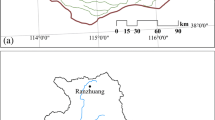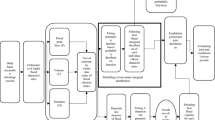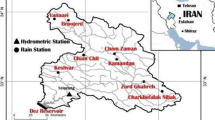Abstract
Copula-based bivariate frequency analysis can be used to investigate the changes in flood characteristics in the Huai River Basin that could be caused by climate change. The univariate distributions of historical flood peak, maximum 3-day and 7-day volumes in 1961–2000 and future values in 2061–2100 projected from two GCMs (CSIRO-MK3.5 and CCCma-CGCM3.1) under A2, A1B and B1 emission scenarios are analyzed and compared. Then, bivariate distributions of peaks and volumes are constructed based on the copula method and possible changes in joint return periods are characterized. Results indicate that the Clayton copula is more appropriate for historical and CCCma-CGCM3.1 simulating flood variables, while that of Frank and Gumbel are better fitted to CSIRO-MK3.5 simulations. The variations of univariate and bivariate return periods reveal that flood characteristics may be more sensitive to different GCMs than different emission scenarios. Between the two GCMs, CSIRO-MK3.5 evidently predicts much more severe flood conditions in future, especially under B1 scenario, whereas CCCma-CGCM3.1 generally suggests contrary changing signals. This study corroborates that copulas can serve as a viable and flexible tool to connect univariate marginal distributions of flood variables and quantify the associated risks, which may provide useful information for risk-based flood control.
Similar content being viewed by others
References
Arnell, N. W., Gosling, S. N., 2013. The Impacts of Climate Change on River Flow Regimes at the Global Scale. Journal of Hydrology, 486: 351–364. doi:10.1016/j.jhydrol.2013.02.010
Ben Aissia, M. A., Chebana, F., Ouarda, T. B. M. J., et al., 2011. Multivariate Analysis of Flood Characteristics in a Climate Change Context of the Watershed of the Baskatong Reservoir, Province of Québec, Canada. Hydrological Processes, 26(1): 130–142. doi:10.1002/hyp.8117
Correia, F. N., 1987. Multivariate Partial Duration Series in Flood Risk Analysis. In: Singh, V. P., ed., Hydrologic Frequency Modeling. Reidel, Dordrecht. 541–554
Cunnane, C., 1987. Review of Statistical Models for Flood Frequency Estimation. In: Singh, V. P., ed., Hydrologic Frequency Modeling. Reidel, Dordrecht. 49–95
Duan, K., Mei, Y. D., 2013. A Comparison Study of Three Statistical Downscaling Methods and Their Model-Averaging Ensemble for Precipitation Downscaling in China. Theoretical and Applied Climatology, 116(3/4): 707–719. doi:10.1007/s00704-013-1069-8
Duan, K., Mei, Y. D., 2014. Comparison of Meteorological, Hydrological and Agricultural Drought Responses to Climate Change and Uncertainty Assessment. Water Resources Management, 28(14): 5039–5054. doi:10.1007/s11269-014-0789-6
Duan, K., Xiao, W. H., Mei, Y. D., et al., 2014. Multi-Scale Analysis of Meteorological Drought Risks Based on a Bayesian Interpolation Approach in Huai River Basin, China. Stochastic Environmental Research and Risk Assessment, 28(8): 1985–1998. doi:10.1007/s00477-014-0877-4
Goel, N. K., Seth, S. M., Chandra, S., 1998. Multivariate Modeling of Flood Flows. Journal of Hydraulic Engineering, 124(2): 146–155. doi:10.1061/(asce)0733-9429(1998)124:2(146)
IPCC, 2014. Climate Change 2014: Impacts, Adaptation, and Vulnerability. Part A: Global and Sectoral Aspects. In: Field, C. B., Barros, V. R., Dokken, D. J., et al., eds., Contribution of Working Group II to the Fifth Assessment Report of the Intergovernmental Panel on Climate Change. Cambridge University Press, Cambridge and New York
Joe, H., 1997. Multivariate Models and Dependence Concepts. Chapman & Hall, London
Klein, B., Pahlow, M., Hundecha, Y., et al., 2010. Probability Analysis of Hydrological Loads for the Design of Flood Control Systems Using Copulas. Journal of Hydrologic Engineering, 15(5): 360–369. doi:10.1061/(asce)he.1943-5584.0000204
Kotz, S., Nadarajah, S., 2000. Extreme Value Distributions: Theory and Applications. Imperial College Press, London
Madsen, H., Rasmussen, P. F., Rosbjerg, D., 1997. Comparison of Annual Maximum Series and Partial Duration Series Methods for Modeling Extreme Hydrologic Events: 1. At-Site Modeling. Water Resources Research, 33(4): 747–757. doi:10.1029/96wr03848
Nelson, R. B., 1999. An Introduction to Copulas. Springer, New York
Salvadori, G., De Michele, C., 2004. Frequency Analysis via Copulas: Theoretical Aspects and Applications to Hydrological Events. Water Resources Research, 40(12): W12511. doi:10.1029/2004wr003133
Seibert, J., 1997. Estimation of Parameter Uncertainty in the HBV Model. Nordic Hydrology, 28(4/5): 247–262
Semenov, M. A., Brooks, R. J., Barrow, E. M., et al., 1998. Comparison of the WGEN and LARS-WG Stochastic Weather Generators for Diverse Climates. Climate Research, 10: 95–107
Semenov, M. A., Stratonovitch, P., 2010. Use of Multi-Model Ensembles from Global Climate Models for Assessment of Climate Change Impacts. Climate Research, 41: 1–14. doi:10.3354/cr00836
Singh, K., Singh, V. P., 1991. Derivation of Bivariate Probability Density Functions with Exponential Marginals. Stochastic Hydrology and Hydraulics, 5(1): 55–68. doi:10.1007/bf01544178
Sklar, K., 1959. Fonctions de Repartition an Dimensions et Leura Marges. Publ. Inst. Stat. Univ. Paris, 8: 229–231
Yue, S., 2000. The Bivariate Lognormal Distribution to Model a Multivariate Flood Episode. Hydrological Processes, 14(14): 2575–2588. doi:10.1002/1099-1085(20001015)14:14<2575:: aid-hyp115>3.0.co;2-l
Yue, S., Wang, C. Y., 2004. A Comparison of Two Bivariate Extreme Value Distributions. Stochastic Environmental Research and Risk Assessment (SERRA), 18(2): 61–66. doi:10.1007/s00477-003-0124-x
Zhang, L., Singh, V. P., 2006. Bivariate Flood Frequency Analysis Using the Copula Method. Journal of Hydrologic Engineering, 11(2): 150–164. doi:10.1061/(asce)1084-0699(2006)11:2(150)
Zhang, L., Singh, V. P., 2007. Trivariate Flood Frequency Analysis Using the Gumbel-Hougaard Copula. Journal of Hydrologic Engineering, 12(4): 431–439. doi:10.1061/(asce)1084-0699(2007)12:4(431)
Author information
Authors and Affiliations
Corresponding author
Rights and permissions
About this article
Cite this article
Duan, K., Mei, Y. & Zhang, L. Copula-based bivariate flood frequency analysis in a changing climate—A case study in the Huai River Basin, China. J. Earth Sci. 27, 37–46 (2016). https://doi.org/10.1007/s12583-016-0625-4
Received:
Accepted:
Published:
Issue Date:
DOI: https://doi.org/10.1007/s12583-016-0625-4




